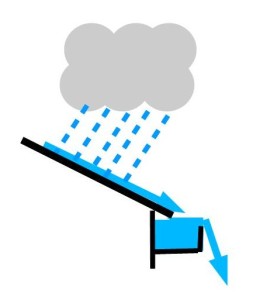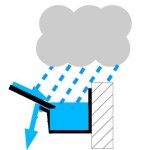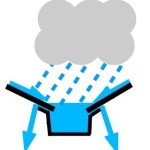Roof Choice – Risk
Something you might never have thought about when thinking about the sort of roof that you want on your new house is Risk.

Low Risk
A conventional roof which slopes to the outside can be considered to be a low risk roof.
In severe weather conditions heavy rain can exceed the capacity of the gutters and the downspouts causing an overflow. Blockages in the gutters and downspouts will also cause overflows
With a conventional roof the gutters will overflow to the outside of the building as shown in the diagram to the right avoiding damage to the inside of your home.
High Risk
A couple of other roof choices are of much higher risk.

These are:
Roof with Parapet
This sort of construction is used to give the effect of a Flat Roof, although there is actually a pitched roof behind the parapet wall.
As you can see from the diagram in severe rain, or a blockage, there is a greater risk of the overflow occurring inside the house.
Butterfly Roof
A butterfly roof is when two pitched roof panels fall to a central box gutter.
Again you can see the real risk of overflow into the house in case of problems.
What the Regulations Say
For a ‘High Risk Roof’ the regulations require the roof plumbing to be be designed for a heavier storm (1 in 100 years), rather than 1 in 20 years for a ‘Low Risk Roof’.
A ‘High Risk Roof’ drainage system also require special overflows to be installed.
This link will show you how to calculate the rate of rainfall used in design: Rainfall Intensity
In practice I hear of a number of non complying plumbing installations, and many of the overflows I see don’t look to have adequate capacity.
Did anyone check your roof drainage calculations? ……..If I chose a high risk roof it would be something I wanted to be checked thoroughly.
Also see Whats on the Roof
and Want a Flat Roof

I’d never thought about this before, appreciate it for putting up.